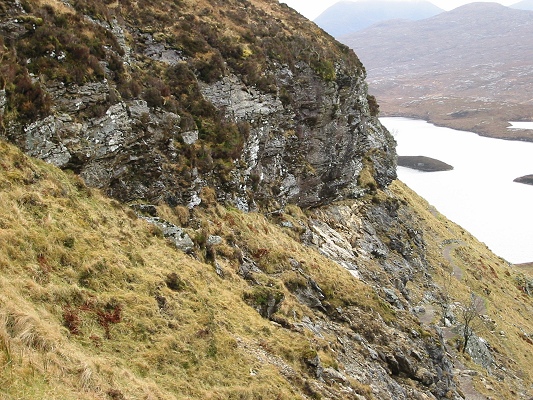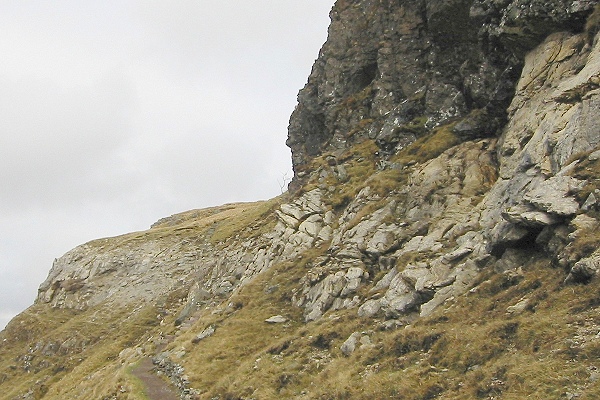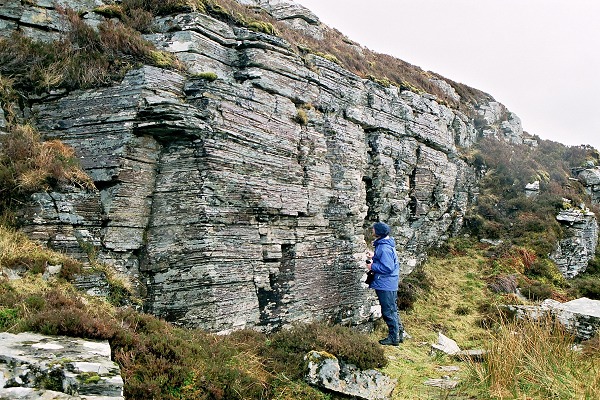
| Home | Geological History | Stratigraphy | Area map | Rock Index | About |
| Scourie | Achmelvich | Laxford | Clachtoll | Stoer | Assynt | Skiag Bridge | Glencoul | Knockan | Borralan | Ledmore |
Knockan Crag is the easiest place to see the Moine Thrust. It lies in the Inverpolly Nature Reserve, and a nature trail leads up and along the crag, through the succession of Cambrian sediments. Above the grey Durness Limestone seen at Skiag Bridge there is a fractured and sheared white limestone. Then, immediately overlying this with a sharp contact, are mylonites, fine-grained platy metamorphic rocks made mostly of mica and quartz. The mylonites were formed by intense shearing of older metamorphic rocks, the Moine Schists. These were originally sandstones and siltstones deposited far away to the south and east, and they were metamorphosed into schists in the earlier stages of development of the Caledonian mountain belt. Then, about 420 million years ago, horizontal forces pushed them many tens of kilometres up and over the Cambrian sedimentary rocks and their basement, into their present position.

![]() View of the outcrop of the Moine Thrust at Knockan Crag,
looking south. The dark layered rock in the upper part of
the photograph is mylonite formed from Moine Schists. The
Moine Thrust itself lies between these dark rocks and the
white Durness limestone in the centre of the photograph.
Below the white limestone can be seen grey Durness
limestone and, behind the small trees, light grey
Salterella Grit.
View of the outcrop of the Moine Thrust at Knockan Crag,
looking south. The dark layered rock in the upper part of
the photograph is mylonite formed from Moine Schists. The
Moine Thrust itself lies between these dark rocks and the
white Durness limestone in the centre of the photograph.
Below the white limestone can be seen grey Durness
limestone and, behind the small trees, light grey
Salterella Grit.

![]() The view in the opposite direction (northwards) gives a
clearer picture of the white sheared limestone beneath the
Moine Thrust plane. Below the path (bottom left), the
limestone becomes darker in colour and more like the
undeformed lower part of the Durness limestone seen at
Skiag Bridge.
The view in the opposite direction (northwards) gives a
clearer picture of the white sheared limestone beneath the
Moine Thrust plane. Below the path (bottom left), the
limestone becomes darker in colour and more like the
undeformed lower part of the Durness limestone seen at
Skiag Bridge.

![]() Outcrop of Moine mylonites above the thrust, showing the
well developed platy texture of the strongly-sheared rocks.
Outcrop of Moine mylonites above the thrust, showing the
well developed platy texture of the strongly-sheared rocks.
|
Brecciated (broken-up) limestone, Cambrian Durness Limestone Knockan Crag |
|
Moine mylonite, Moine Thrust Zone Knockan Crag |
|
Folded Moine mylonite, Moine Thrust Zone Knockan Crag |
| Scourie | Achmelvich | Laxford | Clachtoll | Stoer | Assynt | Skiag Bridge | Glencoul | Knockan | Borralan | Ledmore |
| Home | Geological History | Stratigraphy | Area map | Rock Index | About |
D.J. Waters, Department of Earth Sciences, May 2003